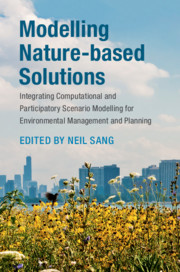 Modelling Nature-based Solutions
Modelling Nature-based Solutions Book contents
- Modelling Nature-based Solutions
- Modelling Nature-based Solutions
- Copyright page
- Contents
- Contributors
- Foreword
- Acknowledgements
- Introduction
- 1 Landscape Modelling and Stakeholder Engagement: Participatory Approaches and Landscape Visualisation
- 2 Agent-based Models of Coupled Social and Natural Systems
- 3 Modelling Nature-based Solutions from Soil Ecosystem Services
- 4 Modelling Water Resources for Nature-based Solutions
- 5 Models at the Service of Marine Nature-based Solutions
- 6 Coastal and Freshwater Flood Models: A Review in the Context of NBS
- 7 Nature-based Solutions to Urban Microclimate Regulation
- 8 Data Mining, Machine Learning and Spatial Data Infrastructures for Scenario Modelling
- 9 Can Geodesign Be Used to Facilitate Boundary Management for Planning and Implementation of Nature-based Solutions?
- 10 Integrating Models into Practice – Recommendations
- Appendix: List of Models/Software
- Index
- Plate Section (PDF Only)
- References
4 - Modelling Water Resources for Nature-based Solutions
Published online by Cambridge University Press: 13 March 2020
- Modelling Nature-based Solutions
- Modelling Nature-based Solutions
- Copyright page
- Contents
- Contributors
- Foreword
- Acknowledgements
- Introduction
- 1 Landscape Modelling and Stakeholder Engagement: Participatory Approaches and Landscape Visualisation
- 2 Agent-based Models of Coupled Social and Natural Systems
- 3 Modelling Nature-based Solutions from Soil Ecosystem Services
- 4 Modelling Water Resources for Nature-based Solutions
- 5 Models at the Service of Marine Nature-based Solutions
- 6 Coastal and Freshwater Flood Models: A Review in the Context of NBS
- 7 Nature-based Solutions to Urban Microclimate Regulation
- 8 Data Mining, Machine Learning and Spatial Data Infrastructures for Scenario Modelling
- 9 Can Geodesign Be Used to Facilitate Boundary Management for Planning and Implementation of Nature-based Solutions?
- 10 Integrating Models into Practice – Recommendations
- Appendix: List of Models/Software
- Index
- Plate Section (PDF Only)
- References
Summary
This chapter first summarises different approaches to hydrological and hydrochemical modelling of freshwater, and then goes on to provide an overview of how models are being used in practice to address typical policy and environmental issues, with a special focus on Nature-based Solutions (NBS). For a broader overview of hydrologic and water quality models the reader is referred to review articles such as Singh and Woolhiser (2002), Borah and Bera (2003), Cox (2003), Kampf and Burges (2007), Schoumans et al. (2009a, 2009b), Arthington et al. (2010), Ampadu et al. (2013), Kelly et al (2013), Li and Heap (2014). Several categories of NBS approaches, as defined by Cohen-Schacham et al. (2016) relate to the water environment. These include: climate adaptation services (e.g. modification of water use through changed agricultural practice), natural/green infrastructure (e.g. natural flood retention ponds), integrated water resources management to meet the needs of multiple stakeholders, and area-based conservation (e.g. protection of wetland areas). These approaches are not specifically new, but can be clustered as part of the overarching NBS concept and contribute to the development of an operational framework for NBS. This chapter considers the role of modelling in evaluating and designing NBS for water.
Information
- Type
- Chapter
- Information
- Modelling Nature-based SolutionsIntegrating Computational and Participatory Scenario Modelling for Environmental Management and Planning, pp. 100 - 151Publisher: Cambridge University PressPrint publication year: 2020